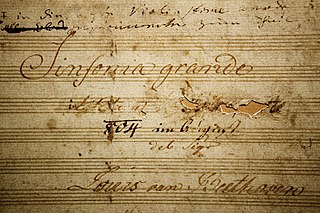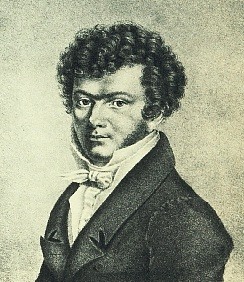Sonata form is a musical structure consisting of three main sections: an exposition, a development, and a recapitulation. It has been used widely since the middle of the 18th century.

Symphony No. 7 by Gustav Mahler was written in 1904–05, with repeated revisions to the scoring. It is sometimes referred to by the title Song of the Night, which Mahler never knew. Although the symphony is often described as being in the key of E minor, its tonal scheme is more complicated. The symphony's first movement moves from B minor (introduction) to E minor, and the work ends with a rondo finale in C major. Thus, as Dika Newlin has pointed out, "in this symphony Mahler returns to the ideal of 'progressive tonality' which he had abandoned in the Sixth". The complexity of the work's tonal scheme was analysed in terms of "interlocking structures" by Graham George.

The Piano Concerto No. 2 in B♭ major, Op. 83, by Johannes Brahms is separated by a gap of 22 years from his first piano concerto. Brahms began work on the piece in 1878 and completed it in 1881 while in Pressbaum near Vienna. It is dedicated to his teacher, Eduard Marxsen. The public premiere of the concerto was given in Budapest on 9 November 1881, with Brahms as soloist and the Budapest Philharmonic Orchestra, and was an immediate success. He proceeded to perform the piece in many cities across Europe.

The Symphony No. 3 in E♭ major, Op. 55, is a symphony in four movements by Ludwig van Beethoven. One of the composer's most celebrated works, the Eroica symphony is a large-scale composition that marked the beginning of Beethoven's creative middle-period.

Étienne Nicolas Méhul was a French composer, "the most important opera composer in France during the Revolution". He was also the first composer to be called a "Romantic".
Symphony No. 5 in D major by English composer Ralph Vaughan Williams was written between 1938 and 1943. In style it represents a shift away from the violent dissonance of Symphony No. 4, and a return to the more romantic style of the earlier Pastoral Symphony. It is also noteworthy as perhaps the quietest symphony Vaughan Williams ever wrote, with only a very few passages rising even to a forte. The texture throughout the work is strongly dominated by the strings.

Ferdinand Ries was a German composer. Ries was a friend, pupil and secretary of Ludwig van Beethoven. He composed eight symphonies, a violin concerto, eight piano concertos, three operas, and numerous other works in many genres, including 26 string quartets. In 1838 he published a collection of reminiscences of his teacher Beethoven, co-written with Franz Wegeler. The symphonies, some chamber works —most of them with piano— his violin concerto and his piano concertos have been recorded, demonstrating a style which is, unsurprising due to his connection to Beethoven, somewhere between those of the Classical and early Romantic eras.
Romeo and Juliet, TH 42, ČW 39, is an orchestral work composed by Pyotr Ilyich Tchaikovsky. It is styled an Overture-Fantasy, and is based on Shakespeare's play of the same name. Like other composers such as Berlioz and Prokofiev, Tchaikovsky was deeply inspired by Shakespeare and wrote works based on The Tempest and Hamlet as well.

The Symphony No. 5 in B-flat major of Anton Bruckner was written in 1875–1876, with minor changes over the next two years. It came at a time of trouble and disillusion for the composer: a lawsuit, from which he was exonerated, and a reduction in salary. Dedicated to Karl von Stremayr, education minister in the Austro-Hungarian Empire, the symphony has at times been nicknamed the “Tragic,” the “Church of Faith” or the “Pizzicato”; Bruckner himself referred to it as the “Fantastic” without applying this or any other name formally.
Symphony No. 35 in D major, K. 385, was composed by Wolfgang Amadeus Mozart in 1782 and is also called the Haffner Symphony. It was commissioned by the Haffners, a prominent Salzburg family, for the occasion of the ennoblement of Sigmund Haffner the Younger. The Haffner Symphony should not be confused with the eight-movement Haffner Serenade, another piece Mozart wrote on commission from the same family in 1776.
Symphony No. 1 in C minor, Op. 68, is a symphony written by Johannes Brahms. Brahms spent at least fourteen years completing this work, whose sketches date from 1854. Brahms himself declared that the symphony, from sketches to finishing touches, took 21 years, from 1855 to 1876. The premiere of this symphony, conducted by the composer's friend Felix Otto Dessoff, occurred on 4 November 1876, in Karlsruhe, then in the Grand Duchy of Baden. A typical performance lasts between 45 and 50 minutes.

Philip Cipriani Hambly Potter was an English musician. He was a composer, pianist, conductor and teacher. After an early career as a performer and composer, he was an early member of the staff of the Royal Academy of Music in London, and became its principal in 1832, remaining in the post until 1859.

The Symphony No. 101 in D major is the ninth of the twelve London symphonies written by Joseph Haydn. It is popularly known as The Clock because of the "ticking" rhythm throughout the second movement.

The Symphony No. 80 in D minor, Hoboken 1/80, is a symphony composed by Joseph Haydn in 1784 as part of a trio of symphonies that also included symphonies 79 and 81. This symphony, along with the one that follows it, and the one that precedes it, were not written for Prince Nikolaus, but for a Lenten concert performed in Vienna in March 1785. It is one of the relatively few later symphonies by Haydn to begin in the minor mode. Symphony No 80 is highly structured with both outer movements in sonata form. There is a common modulation pattern seen in all four movements.

The Symphony No. 5 in C minor of Ludwig van Beethoven, Op. 67, was written between 1804 and 1808. It is one of the best-known compositions in classical music, and one of the most frequently played symphonies. First performed in Vienna's Theater an der Wien in 1808, the work achieved its prodigious reputation soon afterward. E. T. A. Hoffmann described the symphony as "one of the most important works of the time". As is typical of symphonies in the classical period, Beethoven's Fifth Symphony is in four movements.

The conductor Pierre Monteux made a large number of recordings throughout his career. His first recording was as a violist in "Plus blanche que la blanche hermine" from Les Huguenots by Meyerbeer in 1903 for Pathé with the tenor Albert Vaguet. His first recording as a conductor was the first of his five recordings of Stravinsky's The Rite of Spring. His last studio recordings were with the London Symphony Orchestra in works by Ravel at Wembley Town Hall at the end of February 1964. He recorded works by more than fifty composers. However, he disliked recording, saying of studio sessions,
You may give an excellently played, genuinely felt performance of a movement, but because the engineer is not satisfied because there is some rustling at one point, so you do it again and this time something else goes wrong. By the time you get a "perfect" take of the recording the players are bored, the conductor is bored, and the performance is lifeless and boring. … I detest all my own records.

The Concerto for Piano, Violin, and Strings in D minor, MWV O4, also known as the Double Concerto in D minor, was written in 1823 by Felix Mendelssohn when he was 14 years old. This piece is Mendelssohn's fourth work for a solo instrument with orchestral accompaniment, preceded by a Largo and Allegro in D minor for Piano and Strings MWV O1, the Piano Concerto in A Minor MWV O2, and the Violin Concerto in D minor MWV O3. Mendelssohn composed the work to be performed for a private concert on May 25, 1823 at the Mendelssohn home in Berlin with his violin teacher and friend, Eduard Rietz. Following this private performance, Mendelssohn revised the scoring, adding winds and timpani and is possibly the first work in which Mendelssohn used winds and timpani in a large work. A public performance was given on July 3, 1823 at the Berlin Schauspielhaus. Like the A minor Piano Concerto, it remained unpublished during Mendelssohn's lifetime and it wasn't until 1999 when a critical edition of the piece was available.
















